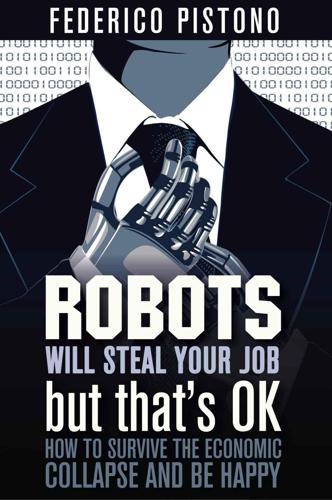
Robots Will Steal Your Job, But That's OK: How to Survive the Economic Collapse and Be Happy
by
Pistono, Federico
Published 14 Oct 2012
Table of Contents Cover Foreword Dedication Preface Acknowledgements Introduction Chapter 1 Unemployment Today Chapter 2 The Luddite Fallacy Chapter 3 Exponential Growth Chapter 4 Information Technology Chapter 5 Intelligence Chapter 6 Artificial Intelligence Chapter 7 Evidence for Automation Chapter 8 Social Acceptance Chapter 9 Unemployment Tomorrow Chapter 10 Work Identity Chapter 11 The Pursuit of Happiness Chapter 12 The Scorpion and the Frog Chapter 13 Growth and Happiness Chapter 14 Income and Happiness Chapter 15 Happiness Chapter 16 Work and Happiness Chapter 17 The Purpose of Life Chapter 18 Practical Advice for Everyone Chapter 19 Make the Future Chapter 20 How to Be Happy Chapter 21 The Future is Beautiful Chapter 22 How a Family Can Live Better by Spending Smart Chapter 23 Growth Notes Bibliography ROBOTS WILL STEAL YOUR JOB BUT THAT’S OK how to survive the economic collapse and be happy FEDERICO PISTONO ROBOTS WILL STEAL YOUR JOB, BUT THAT’S OK COPYRIGHT © 2012 FEDERICO PISTONO COVER DESIGN – FEDERICO PISTONO BOOK DESIGN – FEDERICO PISTONO CREATESPACE – NOVEMBER 5, 2012 ISBN–10: 1479380008 ISBN–13: 978-1479380008 SOME RIGHTS RESERVED This work is licensed under a Creative Commons Attribution NonCommercial ShareAlike 3.0 Unported License.
…
Today, most of the economy is a ’ghost economy’ of financial transactions, profit-maximisation schemes and computer algorithms, with little regard to their consequences. We allowed power to be accrued in the hands of a few to the point of insanity. Today, a small group of 147 mega transnational corporations form a giant bow-tie structure, an economic super-entity that controls 40% of the entire world.134 What have we become? Chapter 12 The Scorpion and the Frog One day, a scorpion looked around at the mountain where he lived and decided that he wanted a change. So he set out on a journey through the forests and hills. He climbed over rocks and under vines and kept going until he reached a river. The river was wide and swift, and the scorpion stopped to reconsider the situation.
…
Halfway across the river, the frog suddenly felt a sharp sting in his back and, out of the corner of his eye, saw the scorpion remove his stinger from the frog’s back. A deadening numbness began to creep into his limbs. “You fool!” croaked the frog, “Now we shall both die! Why on earth did you do that?” The scorpion shrugged, and did a little jig on the drownings frog’s back. “I could not help myself. It is my nature.” This is a story often told in psychology classes to understand the immutable nature of something is vital. There is no point intellectualising, making excuses and developing competing analyses, sometimes something just is what it is.
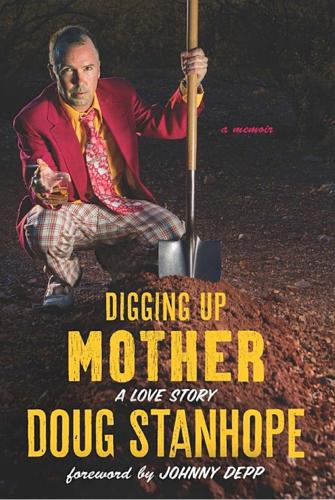
Digging Up Mother: A Love Story
by
Doug Stanhope
Published 9 May 2016
He was one of those people I’d meet more of throughout the years, a guy who is really extremely bright but comes off as a dunce because he has a hard time communicating. I remember smoking cigarettes that night with my brother, Dori, and Mikey—all fully ablaze now—while Mikey tried to tell the parable of The Scorpion and the Frog. We’d never heard it before and Mikey had us completely engrossed as he stammered and mumbled his way through it, forgetting parts and having to start over. By the end, we were on the edge of our seats. “And then the frog says, like, ‘Why did you sting me?’ And, uh, the scorpion says, um . . .
…
I didn’t bother getting a subscription but I kept the note. One day I came back to the Spahn Ranch and found a three-day eviction notice. Seems the junkie hadn’t been giving whoever owned the place any of that rent money after all. I confronted him and he just shrugged it off with, “What did you expect, man? I’m a junkie.” It was the parable of the Scorpion and the Frog. He was a junkie and therefore it was his nature. Or, as Mikey would have said, “Just cuz.” Meanwhile, I’d been dating/banging a girl named Pandora Tranowski, a seamstress who also worked part-time as a hostess at an S&M dungeon. I’d been set up on a blind date with her and it was very casual, but now that I was out on my ass, I conveniently wanted to take it to the next level.

Radical Uncertainty: Decision-Making for an Unknowable Future
by
Mervyn King
and
John Kay
Published 5 Mar 2020
Among New Zealanders of Polynesian or Asian descent, lactose intolerance is still relatively common. 19 But over time, intermarriage and natural selection will erode these genetic differences. Evolution creates predispositions – to consume a diet rich in dairy products or to trust other people – which influence behaviour. Such predispositions can be overcome with greater or lesser difficulty by conscious effort, as the parable of the scorpion and the frog relates: A scorpion asks a frog to carry it across a river. The frog hesitates, afraid of being stung, but the scorpion argues that if it did so, they would both drown. Considering this, the frog agrees, but midway across the river the scorpion does indeed sting the frog, dooming them both.
…
Y., 110 Edison, Thomas, 431 Edmond de Belamy (computer created portrait), 176 education system, 409 efficient market hypothesis, 252 , 254 , 308–9 , 318 , 320 , 332 , 336–7 Egypt, ancient, 142 Ehrlich, Paul, The Population Bomb (1968), 359 , 362 Einstein, Albert, 19–20 , 259 Eisenhower, Dwight D., 279 , 282 , 292 , 293–4 Eliot, George, Middlemarch , 220 Elizabeth II, Queen, 382–3 , 393 Ellsberg, Daniel, 135 , 136 , 282 emerging economies, 315–16 engineering, 23–4 , 33 , 383 , 384 , 390–1 , 399 Enlightenment, eighteenth-century, 163 , 187 , 387 entrepreneurship, 15 , 49 , 74 , 170 , 258 , 275–6 , 337 , 405 , 430–2 environmentalism, 220 , 361 , 362 Equitable Life Assurance Society, 56 , 328 Ethereum, 96 eugenics, 158 European Central Bank, 350 European Monetary System, 319 European Monetary Union, 45 , 316 European Union, 369–70 , 372 eusociality, 172–3 , 274 evolutionary science: adaptation, 401 ; application to economics, 158 ; and behavioural economics, 154–5 ; co-evolution, 163–4 , 429 , 430–1 ; coping strategies for uncertainty, 47 , 155 ; and decision making, 47 , 171–2 , 177 , 272 , 401 ; discovery and development of, 156 , 157–8 ; an essentially continuous process, 407 , 428–9 , 430–1 ; evolutionary psychology, 416–17 ; and extinctions, 32 ; false association with far-right causes, 158 , 161 ; and intentionality, 431 ; language and communication, 159 , 161–2 , 272 ; and learning of complex skills, 268 , 274–5 , 408 ; nature and nurture, 164–5 ; non-scientific mechanisms of, 158–9 ; optimism and confidence, 167–70 , 330 , 427–8 ; parable of the scorpion and the frog, 164 ; predispositions influencing behaviour, 163–5 ; and rationality, 16–17 , 47 , 152–3 , 155 , 157 , 162 , 171–3 , 272 , 401 ; and risk, 129 , 160–1 , 162 , 166 , 170 , 171 ; the ‘selfish gene’, 156 ; social and cultural practices, 156–65 , 408 ; and survival, 165–7 , 401 ; and trust, 162–3 , 165 ; uncertainty as essential, 428–9 , 431 executive pay, xiv , 409 expected value , concept of, 60 , 106–9 , 114–16 , 124–5 ‘expert’ forecasters, 21–2 , 221–2 Falklands War (1982), 291 , 295 falsificationism, 259–60 Fama, Eugene, 252 , 318 , 320 Fauchard, Pierre, 387 Federal Reserve, US, 103 , 317–18 Ferguson, Adam, 163 , 343 Ferguson, Sir Alex, 273 Fermat, Pierre de, 53 , 56 , 57 , 59–60 , 106 Fermi, Enrico, 84 , 129 Feynman, Richard, 373 , 374 fiction, works of, 92–3 , 212–13 , 219 , 220 , 224–6 , 344 , 397 finance theory: beta coefficients, 332–3 ; capital asset pricing model (CAPM), 307–8 , 309 , 320 , 332 , 334 ; covariances , 332–3 , 366–7 ; definition of risk, 420–1 ; efficient market hypothesis, 252 , 254 , 308–9 , 318 , 320 , 332 , 336–7 ; efficient portfolio model, 307–8 , 309 , 318 , 320 , 332–4 , 366 ; limits of, 318–21 ; quest for large-world model, 392 ; risk as volatility, 124–5 , 310 , 333 , 336 ; three pillars of, 309–10 , 320 , 332 financial crisis (2007–08): and Bank of England ‘fan charts’, 105 ; bankers attribute to chance, 266–7 ; and evolutionary theory, 158–9 ; failure of economic models, xv , 6–7 , 260 , 311–12 , 319 , 339 , 349–50 , 357 , 367–8 , 399 , 407 , 423–4 ; financial sector output after, 95 ; Goldman Sachs risk models, 6–7 , 9 , 68 , 202 , 246–7 ; greedy bankers as risk averse, 127–8 ; and historical narratives, 356–7 ; as intellectual failure, 12 , 319 , 320–1 ; and narrative reasoning, 5–6 ; as not unpredictable/unavoidable, 402–3 ; and pernicious narrative, 410–11 ; prevailing narrative changed by, 351 ; the Queen on, 382–3 , 393 ; and ‘real business cycle’ models, 348 ; recession after, 338–9 ; and ‘thick description’, 193–4 ; volatility and risk, 422–3 financial instruments, 6 , 351 , 366–7 , 401 financial sector: and assumptions of stationarity, 333 , 339 , 340–1 , 349 , 350 , 366–7 ; Basel regulations, 310 , 311 ; broad asset categories, 333–4 ; broad portfolio diversification, 333–5 ; ‘call’ and ‘put’ options, 422–3 ; correlations based on historic data sets, 333 , 366–7 , 390 , 406 ; dominance of narratives, 229–30 , 314–16 , 410–11 ; Dr Evil strategy, 229 , 255 ; executive pay, xiv , 409 ; and expected utility theory, 127 ; failure of finance theory, 318–21 ; government index-linked bonds, 330–1 ; inadequacy of forecasting models, 347–50 , 353–4 , 403–4 ; LIBOR scandal, 192 ; need for strong regulation, 313–14 ; as non-stationary, 16 , 202–3 , 268–9 , 320–1 , 331 , 333 , 339 , 366–8 , 402–3 , 406 ; and normal distribution, 233 ; and power laws, 238–9 ; rescue from collapse (2008), 95 , 311 ; risk and volatility, 124–5 , 310 , 333 , 335–7 , 421–3 ; securitisation, 311 , 316 – 18 , 366–7 , 401 ; securitised mortgages, 311 , 317 , 367 , 372 , 390 , 422–3 ; stock market crashes, 238 , 331 , 354 ; US stock market crash (19 October 1987), 238 ; US subprime mortgage market, 317 , 367 , 390 , 422–3 ; Value at risk models (VaR), 366–8 , 405 , 424 ; see also securities trading Financial Times , xiii Finetti, Bruno de, 73 , 80 , 135 First World War, 357 , 361 Fisher, R.
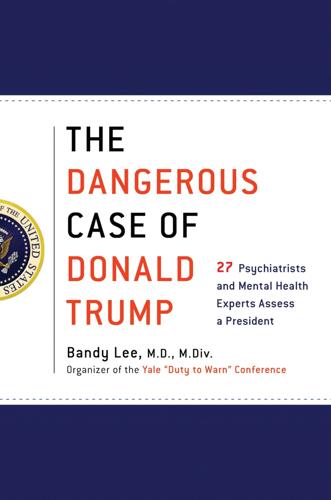
The Dangerous Case of Donald Trump: 27 Psychiatrists and Mental Health Experts Assess a President
by
Bandy X. Lee
Published 2 Oct 2017
The snake says, “You knew damn well I was a snake before you took me in.” I thought Trump was speaking about himself, and the American people were the tenderhearted woman. It turned out he was speaking about immigrants as being vicious snakes. This story is similar to other animal fables, perhaps best illustrated by the story of the scorpion and the frog, which is told in various forms. In one telling, a scorpion asks a frog to carry him on his back in a swim across a pond. The frog is reluctant, fearful of the scorpion’s sting. The scorpion argues that he obviously won’t sting the frog, because if he does, they will both drown. So, they start crossing the pond, and midway across, the scorpion stings the frog.

Madoff: The Final Word
by
Richard Behar
Published 9 Jul 2024
“They can do things for a very long time and take advantage of people who are friends, they can rip off their mothers, and rip off their grandmothers. And people say, ‘I’m shocked he did that.’ No, that’s what’s to be expected. And it’s that lack of remorse, that lack of pity.” That certainly sounds like our Bernie. And it calls to mind the timeless joke about the scorpion and the frog, in which the former asks the latter to carry it across a river on its back. The frog hesitates, fearful of being stung, but the scorpion points out that “If I did, both of us would drown.” The frog sees the scorpion’s logic and agrees to take him, but midway across, the scorpion stings the frog, and they both begin to go under.

The Wisdom of Psychopaths: What Saints, Spies, and Serial Killers Can Teach Us About Success
by
Kevin Dutton
Published 15 Oct 2012
But halfway across, the frog suddenly feels a sharp pain in his back—and sees, out of the corner of his eye, the scorpion withdraw his stinger from his hide. A deadening numbness begins to creep into his limbs. “You fool!” croaks the frog. “You said you needed to get to the other side to conduct your business. Now we are both going to die!” The scorpion shrugs and does a little jig on the drowning frog’s back. “Mr. Frog,” he replies casually, “you said it yourself. I am a scorpion. It is in my nature to sting you.” With that, the scorpion and the frog both disappear beneath the murky, muddy waters of the swiftly flowing current. And neither of them is seen again. Bottom Line During his trial in 1980, John Wayne Gacy declared with a sigh that all he was really guilty of was “running a cemetery without a license.”

Amazon Unbound: Jeff Bezos and the Invention of a Global Empire
by
Brad Stone
Published 10 May 2021
Ad execs argued that sellers and vendors would benefit from having their products appear at the top of search results. Retail executives worried customers might be led astray by ads for low-quality products, have a bad experience, and decrease their overall spending on the site. In one debate, Doug Herrington, chief of the domestic retail division, used the parable of the scorpion and the frog to frame the issue. In the story, the scorpion asks the frog if it can climb onto its back for passage across a river, then can’t help but sting the frog along the way, dooming both. His counterparts in advertising were the scorpion—they weren’t evil, per se, but it was simply in their nature to pervert the more egalitarian playing field of the authentic search results.

The Bill Gates Problem: Reckoning With the Myth of the Good Billionaire
by
Tim Schwab
Published 13 Nov 2023
The allegation isn’t that Bill Gates is trying to hurt companies out of some pathological sadism but, rather, that he is unwittingly maiming his charitable partners out of pathological narcissism, that the foundation’s father-knows-best ethos, a clear holdover from Gates’s days at Microsoft, compels it to act in an anti-competitive manner. One company that formerly worked with the foundation brought up the fable of “The Scorpion and the Frog.” As the story goes, the scorpion needs to cross the river, but it doesn’t know how to swim. So, it asks the frog to carry it across. The frog reluctantly agrees. Halfway across the river, the scorpion stings the frog. As the two struggle in the water and begin to drown, the frog asks the scorpion why it would do such a thing.
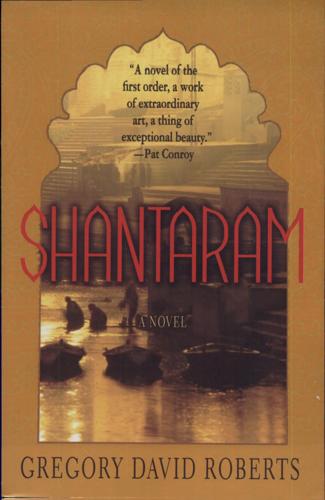
Shantaram: A Novel
by
Gregory David Roberts
Published 12 Oct 2004
I don’t know what his story is,’ she replied, frowning again. ‘His parents died, leaving him a lot of money. He spent it, and I think he developed something of a talent for spending money.’ ‘Other people’s money?’ I asked. I might’ve seemed too eager for that to be true, because she answered me with a question. ‘Do you know the story of the scorpion and the frog? You know, the frog agrees to carry the scorpion across the river, because the scorpion promises not to sting him?’ ‘Yeah. And then the scorpion stings the frog, half way across the river. The drowning frog asks him why he did it, when they’ll both drown, and the scorpion says that he’s a scorpion, and it’s his nature to sting.’
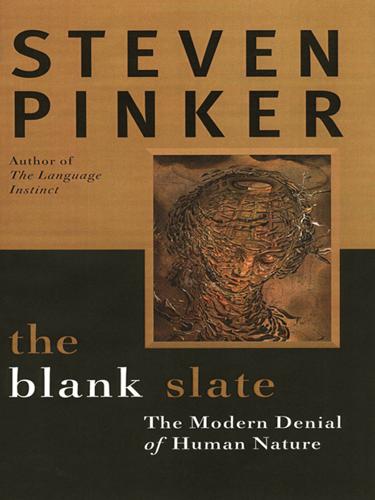
The Blank Slate: The Modern Denial of Human Nature
by
Steven Pinker
Published 1 Jan 2002
But some of the most painful shocks come from the social world—from the manipulations and betrayals of other people. According to the fable, a scorpion asked a frog to carry him across a river, reassuring the frog that he wouldn’t sting him because if he did, he would drown too. Halfway across, the scorpion did sting him, and when the sinking frog asked why, the scorpion replied, “It’s in my nature.” Technically speaking, a scorpion with this nature could not have evolved, but Trivers has explained why it sometimes seems as if human nature is like the fabled scorpion nature, condemned to apparently pointless conflict.